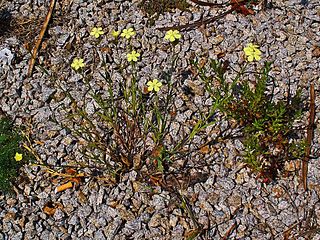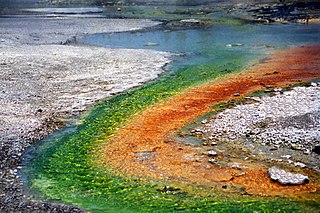
Phylogenesis is the biological process by which a taxon appears. The science that studies these processes is called phylogenetics.
The metabolic theory of ecology (MTE) is the ecological component of the more general Metabolic Scaling Theory and Kleiber's law. It posits that the metabolic rate of organisms is the fundamental biological rate that governs most observed patterns in ecology. MTE is part of a larger set of theory known as metabolic scaling theory that attempts to provide a unified theory for the importance of metabolism in driving pattern and process in biology from the level of cells all the way to the biosphere.
Mesophytes are terrestrial plants which are adapted to neither particularly dry nor particularly wet environments. An example of a mesophytic habitat would be a rural temperate meadow, which might contain goldenrod, clover, oxeye daisy, and Rosa multiflora. Mesophytes prefer soil and air of moderate humidity and avoid soil with standing water or containing a great abundance of salts. They make up the largest ecological group of terrestrial plants, and usually grow under moderate to hot and humid climatic regions.

Saccharomycotina is a subdivision (subphylum) of the division (phylum) Ascomycota in the kingdom Fungi. It comprises most of the ascomycete yeasts. The members of Saccharomycotina reproduce by budding and they do not produce ascocarps.

The middle lamella is a layer that cements together the primary cell walls of two adjoining plant cells. It is the first formed layer to be deposited at the time of cytokinesis. The cell plate that is formed during cell division itself develops into middle lamella or lamellum. The middle lamella is made up of calcium and magnesium pectates. In a mature plant cell it is the outermost layer of cell wall.

Sasha Skenderija is a Bosnian-American poet currently residing in Prague.
Gametogamy is sexual fusion – copulation or fertlization – of two single-celled gametes of different sex and the union of their gamete nuclei giving the zygote nucleus, as well as whole zygotic content.
Minuartia bosniaca, or Bosnian sandwort, in Bosnian bosanska mišjakinjica, is endemic plant at East Dinaric mountains. Itbelongs to family of Caryophyllaceae (carnations).

Campanula hercegovina, the Herzegovinian bellflower, is an endemic plant from Bosnia and Herzegovina. It belongs to the Campanulaceae, or bellflower, family.
Asperula hercegovina, commonly known as the Hercegovinian woodruff, is a herb endemic to Bosnia & Herzegovina of the Rubiaceae family.
Euphorbia gregersenii, or Gregersen's spurge, is a plant in the family Euphorbiaceae: spurges.

Dianthus knappii, or Knapp's carnation, in Bosnian Knapov karanfil or Knapov klinčić, is a perennial herbaceous plant in the carnation family, Caryophyllaceae. It is endemic at Dinaric mountains, on the border area between Herzegovina and Montenegro. In chromosome set has 2n = 30.
Dianthus freynii, or Freyn's carnation, in Bosnian Freynov karanfil or Freynov klinčić, is a plant that is endemic of Herzegovina karst, Bosnia and Herzegovina. It belongs to the family Caryophyllaceae (carnations).

Thermophyte is an organism which is tolerant or thriving at high temperatures. These organisms are categorized according to ecological valences at high temperatures, including biological extremely. Such organisms included the hot-spring taxa also.

A hygrophyte is a plant that inhabits moist areas and is intolerant of dry conditions. The species may inhabit wet and dark forests and islands, dense swamps, and wet meadows. Within the group of all types of terrestrial plants, they are least resistant to drought.

Oxytropis prenja G. Beck in Reichenb. & Reichenb. Fil. is a species of flowering plant in the legume family, Fabaceae.

Institute for Genetic Engineering and Biotechnology (INGEB) is a Bosnian public research institute, member of Sarajevo University (UNSA), and affiliate center of International Centre for Genetic Engineering and Biotechnology (ICGEB).

Unsuccessful transfer or abortive transfer is any bacterial DNA transfer from donor cells to recipient cells that fails to survive transduction and conjugation. In all cases, the transferred fragment could be diluted during the proliferation phase. Failures in the integration of the transferred DNA in the genetic material of the recipient cells may be due to:
Adaptive type – in evolutionary biology – is any population or taxon which have the potential for a particular or total occupation of given free of underutilized home habitats or position in the general economy of nature. In evolutionary sense, the emergence of new adaptive type is usually a result of adaptive radiation certain groups of organisms in which they arise categories that can effectively exploit temporary, or new conditions of the environment.











